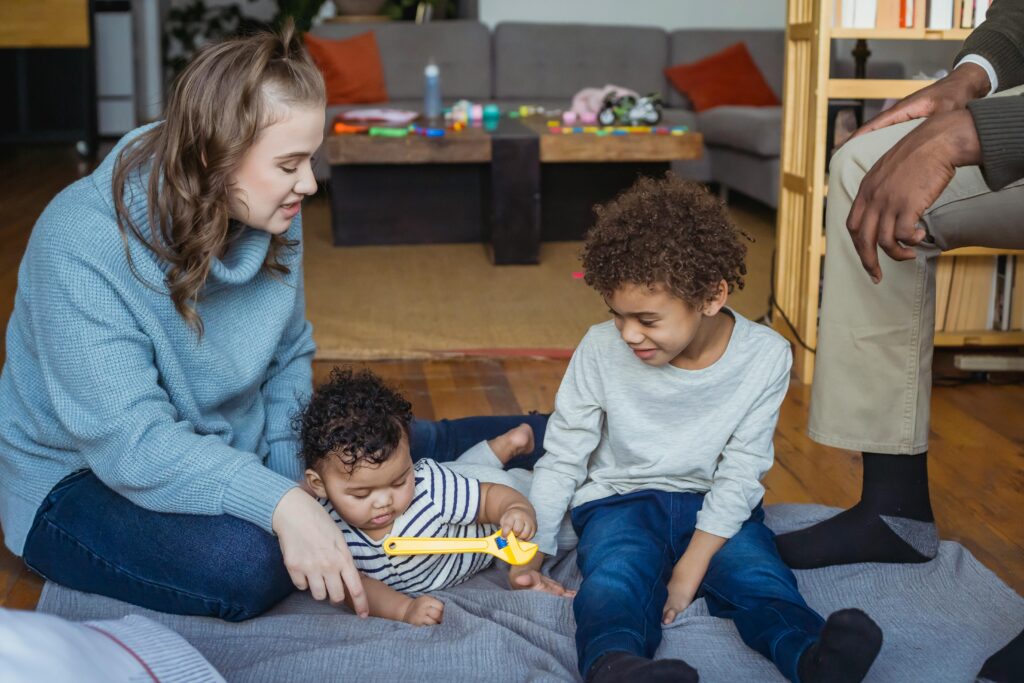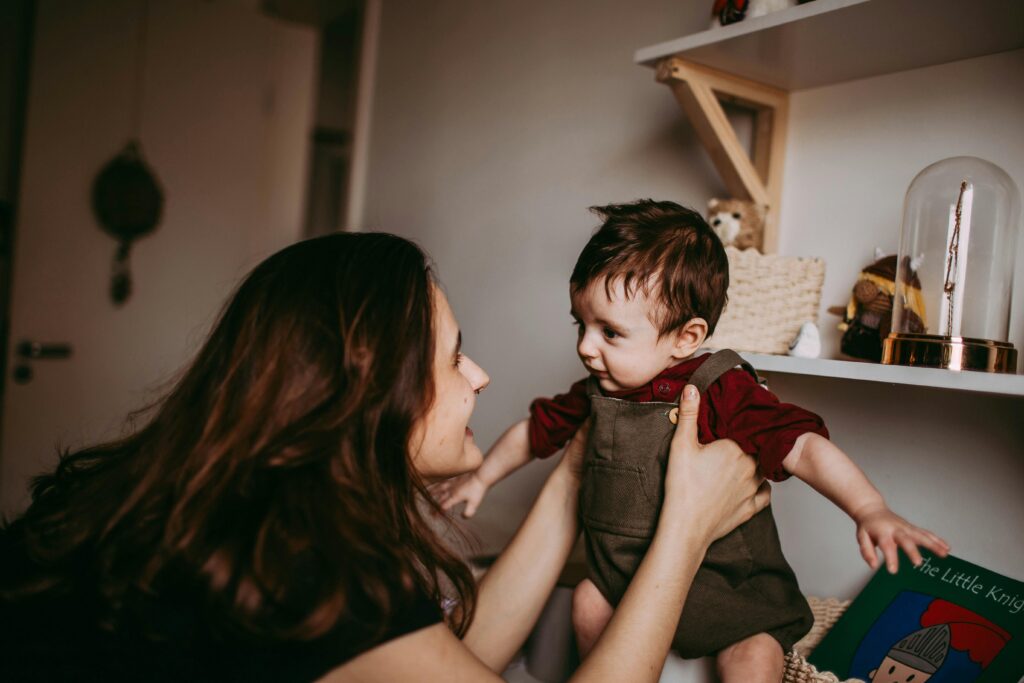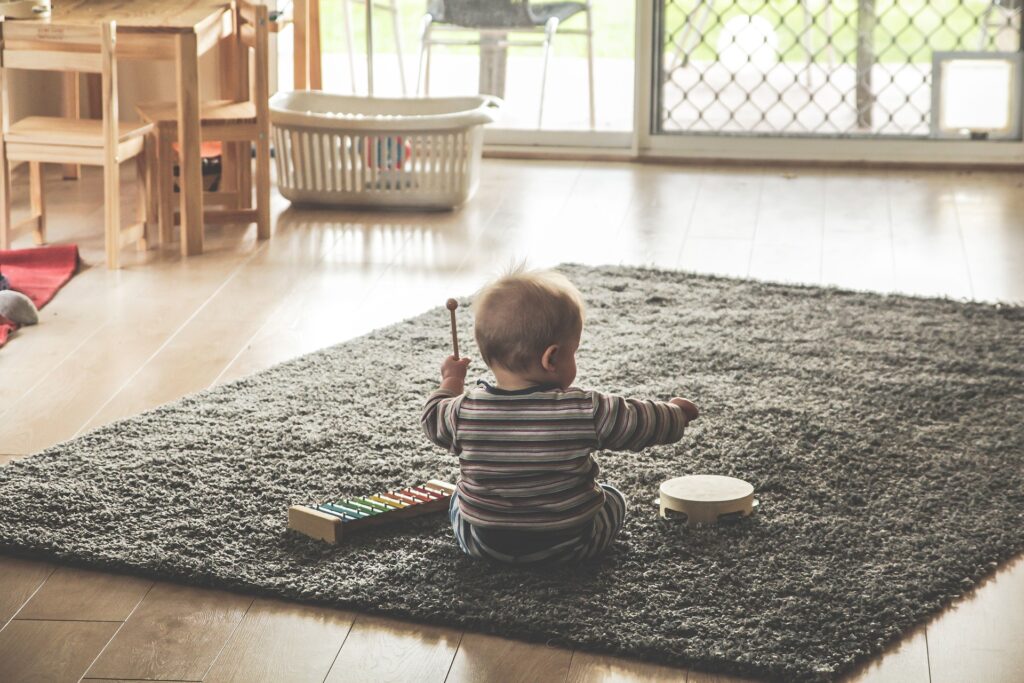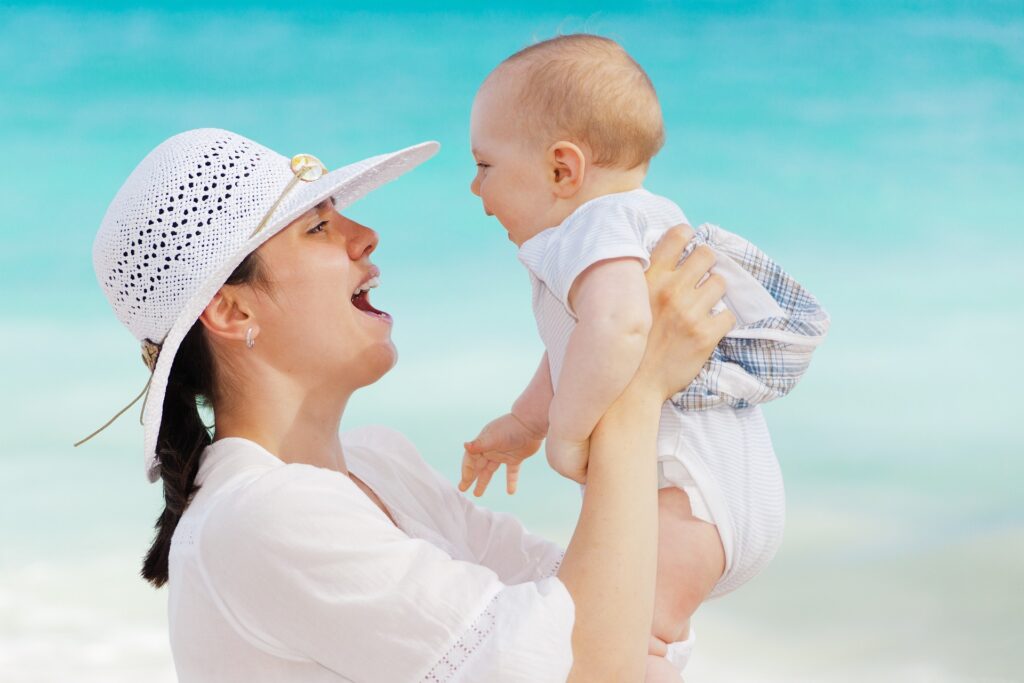One of the most amazing elements of human development is the way language develops in infancy. It reveals the intrinsic skills and complex mechanisms that allow a newborn to become a good communicator. Infants begin their journey of auditory discovery as soon as they are born, and even before. Over time, they develop into beings that can comprehend and express their needs, wants, and thoughts through language. Numerous elements, including as genetic predispositions, the diversity of the language environment, and the caliber of social interactions, have an impact on this voyage, which is full of babbling sounds, the joy of first words, and the complexity of early sentences.
Educators, researchers, and caregivers all need to understand how infants begin to understand and use language. It illuminates the amazing powers of the human brain and offers guidance on how to best foster and support these growing abilities. This article examines the phases of newborn language development, from auditory experiences during pregnancy to the rapid expansion of vocabulary throughout toddlerhood, and the different elements that impact this amazing process. Examining the process from sounds to words helps us understand the intricate and exquisite development that results in linguistic proficiency.

The Foundations of Language Development
Prenatal Education
Even before a baby is born, language development starts at a very young age. A fetus can hear and react to sounds from the outside world by the third trimester of pregnancy. According to research, fetuses are able to identify and distinguish between a variety of sounds, including their mother’s voice’s melodic and rhythmic rhythms. Prenatal auditory exposure is important because it helps babies learn their mother’s voice and their native language’s intonation patterns as soon as they are born.
Research utilizing methods like fetal heart rate monitoring have shown that fetuses respond to sounds differently depending on whether they are familiar or new. For example, when they hear their mother’s voice as opposed to a stranger’s, their heart rates may rise. Because of this early awareness, which lays the groundwork for language development, babies are predisposed to understand human speech from the minute they are born.
The Initial Year: Hearing and Talking
Newborns: Listening to Noises
Infants show a remarkable sensitivity to sounds surrounding them from infancy. They excel at differentiating between phonemes, which are the smallest units of sound in speech. This skill is crucial because it enables babies to start identifying the linguistic components of their original tongue. According to studies, babies can distinguish between the sounds of foreign and native languages within a few days of birth.
Speech sounds are preferred by newborns over non-speech sounds. Their greater neural reactions to speech and longer attention spans are clear indications of this predilection. Additionally, even before they comprehend the words themselves, they are able to divide speech into meaningful units due to their sensitivity to the prosodic aspects of speech, including as rhythm, pitch, and intonation.
0–3 Months: Initial Speeches
During the first three months of their lives, babies mostly use their cries, coos, and reflexive noises like gurgling and sighing to communicate. Although they are not yet language-specific, these early vocalizations are vital for a number of reasons. For example, crying enables babies to communicate their demands and discomforts to caregivers, which in turn triggers actions that are vital to their life and welfare.
At six to eight weeks of age, an infant will start crowing, which is characterized by prolonged vowel sounds like “oo” and “aa.” These sounds are a reflection of their increasing control over their vocal apparatus and their enjoyment of social interactions. When their infants coo, caregivers frequently react with enthusiasm, starting “conversations” with them that set the stage for later spoken interactions.
4-6 Months: The Start of Babbling
Babbling occurs when an infant is four to six months old. This stage is important for a number of reasons. Babbling is the recurrent production of consonant-vowel combinations such as “ba-ba,” “da-da,” and “ma-ma.” It first symbolizes the baby’s attempts to mimic sounds they hear in their surroundings and their exploration with spoken sounds.
Additionally, babble is necessary for the development of the motor abilities needed to produce speech. Babbling is how babies practice using their lips, tongues, and vocal chords. It’s interesting to note that babbling sounds strikingly similar in many languages, indicating that this stage of language development is universal.
Babbling evolves into more intricate and varied speech, utilizing a wider variety of sounds and syllable combinations. Babies also start to mimic the prosodic elements of the speech they hear from caregivers by adjusting their pitch and intonation. For the purpose of creating the foundation for more sophisticated language abilities, this stage of language development is essential.
Social Interaction’s Role
Caregiver-Child Relationships
The social connections that caregivers and babies have are essential to the development of language. The best way for infants to learn language is through engaged and responsive interactions with their caretakers. “Parentese,” also known as “infant-directed speech,” is a highly influential type of communication. It is distinguished by a slower tempo, higher pitch, and exaggerated intonation, all of which better grab an infant’s attention than standard adult speech.
According to research, infants prefer to listen to speech that is directed toward them, and it is very important for them to learn how to recognize the patterns and sounds of their original language. Parentese is a speech pattern that caregivers naturally employ with infants, and research has shown that it is advantageous in a variety of linguistic and cultural contexts. Infants learn to segment speech and begin connecting sounds to meanings more easily when caregivers simplify and emphasize prosodic aspects of their speech.
Combined Focus
Joint attention is another crucial component of language development, wherein the newborn and caregiver concentrate on the same thing or activity. This shared focus facilitates the development of vocabulary in newborns by teaching them to correlate words with objects and activities. An newborn learns to associate the word “ball” with an object when, for instance, a caregiver points to a ball and says, “ball.” Infants begin joint attention interactions by pointing or staring at items of interest, and as time goes on, these interactions become more complex.
Social communication abilities also rest on the foundation of joint attention. It teaches babies the fundamentals of taking turns and the value of maintaining eye contact when speaking. Later in life, more sophisticated social interactions and language use depend on these early abilities. Research has indicated that babies who participate in more joint attention activities as they get older typically develop larger vocabularies and more sophisticated language skills.

Understanding Language: Comprehension Before Production
Early Understanding
Receptive language, or an infant’s understanding of language, develops much before verbal production. Infants that are six months old are able to identify familiar words, particularly their names, and they exhibit a preference for hearing words that they have already encountered. This early understanding is an important developmental milestone because it shows that babies are beginning to create a mental lexicon, or database of words and their definitions.
Eye-tracking research has shown that even very young babies can comprehend words when they are given context. For instance, children frequently focus longer on the image that matches when given two images and a word that corresponds to one of the images. Finding words that fit their referents is a fundamental skill for learning languages later on.
The Significance of Background
In order to understand language, context is essential. To understand spoken language, infants employ contextual cues including gestures, facial expressions, and surroundings. Using both aural and visual cues, a newborn will learn to associate the word “ball” with an object, such as when a caregiver points to a ball and says, “Look at the ball.”
Additionally, context clarifies for young children the meaning of unfamiliar or confusing terms. An child may not grasp the word “cup,” for instance, but if the caregiver uses it frequently while holding or mentioning a cup, the infant will eventually come to identify the term with the object. Through a technique called “fast mapping,” newborns can pick up new word meanings quickly with little exposure.
The Function of Motions
An essential component of early communication is gestures. Before they can talk, babies frequently use gestures like pointing, waving, or reaching to communicate ideas. Infants use these gestures to express their needs and interests as well as to help them learn language.
In interpreting and reacting to these gestures, caregivers are vital. An infant’s association between a gesture and its related word is strengthened when a caregiver acknowledges the object or action in response to the gesture. When a baby points to a dog and its caregiver responds, “Yes, that’s a dog,” for instance, the baby begins to link the word “dog” with the animal.
The use of gestures can predict language development later on, according to research. More gestural babies eventually develop greater vocabularies and more sophisticated verbal abilities. Thus, early language development can be supported by promoting the use of gestures and appropriately responding to them.

The Change from Babble to Talking: The Transition to Words
Opening Phrases
Most babies pronounce their first words between the ages of 10 and 15 months. These first words are usually simple and relate to their immediate environment, such “ball,” “mama,” “dada,” or “milk.” The infant’s everyday experiences and interactions are reflected in these first words, which usually consist of recognizable things, people, or actions.
The utterance of the first words is a crucial turning point in language development. It shows that the baby is beginning to grasp language’s symbolic nature, which holds that words stand for ideas, actions, and things. The development of more sophisticated linguistic abilities depends on this comprehension.
During the babble stage, sounds are frequently formed that lead to the first words. For instance, a baby that cries “ma-ma” a lot may begin referring to their mother as “mama”. The process of turning the constant stream of babble into discrete words is necessary to move from babbling to meaningful speaking.
Explosion of Vocabulary
Around the age of 18 months, a lot of babies go through a “vocabulary explosion,” when they pick up words very quickly. Infants may pick up numerous new words every day at this time. Their increasing social interactions, better memory, and growing capacity to separate words from continuous speech all contribute to this explosion of vocabulary.
There are several reasons for this quick increase in vocabulary. First, as their cognitive capacities develop, babies are better able to recall and retain words. Second, they have more opportunity to hear and use new words as a result of their expanding social and communicative experiences. Lastly, babies get better at deducing the meanings of new words from context cues.
Another factor contributing to the development of vocabulary is the “naming insight”—the understanding that things and behaviors have names. Babies are tremendously motivated to learn the names of everything around them once they have this idea. Their ability to express themselves more clearly and to lay the groundwork for future language proficiency depends on this phase of fast vocabulary expansion.
Word Combining: The Development of Syntax
As babies’ vocabulary grows, they start putting words together to create rudimentary sentences. This stage, which typically lasts between 18 and 24 months, is when syntax—the principles guiding sentence structure—emerges. Early combinations usually consist of two-word phrases that show the infant’s grasp of basic grammatical relationships, such as possession, action, and description. Examples of these phrases are “more juice,” “big truck,” and “mommy go.”
The ability of a newborn to move beyond single words and begin building coherent sentences is symbolized by the development of syntax, which is an important developmental milestone. Understanding word relationships and word order is necessary for this skill. In the case of “big truck,” for instance, the baby knows that “big” refers to the truck, while in “mommy go,” “mommy” is the topic and “go” is the action.
Infants’ sentences get longer and contain more words and grammatical structures as their syntactic abilities continue to improve. Many kids can compose multiword sentences and employ a range of grammatical structures by the time they are three years old, including possessives, plurals, and several verb tenses. The advancement of syntactic development is essential for both language acquisition and efficient communication.

Elements Affecting the Development of Language
Individual Variations
Infants differ greatly in how they develop their language skills due to a variety of factors, including temperament, heredity, and the quality of their language intake. While some babies speak sooner than others, some could take longer to say their first words but pick up on them rapidly. It is critical to understand that there is a large range of developmental paths and that these variations are normal.
There are various reasons why language development varies throughout individuals. Research indicates that language skills are inherited, indicating the importance of genetic factors. Strong language skills run in the family, therefore babies raised in such households are more likely to grow up to be proficient language users.
Language development is also influenced by temperament. For instance, children that are more gregarious and outgoing may be more likely to practice their language skills and participate in social interactions, which could accelerate language acquisition. Conversely, more reserved babies could take longer to speak, but they might also have early good comprehension abilities.
The caliber and volume of language input are other important considerations. Babies who are raised in a bilingual environment, where their caregivers communicate, read, and interact with them on a regular basis, are more likely to acquire more language abilities. On the other hand, a lack of linguistic input might hinder language acquisition.
The Role of Genetics
Language development is significantly influenced by genetic factors. Research have demonstrated that phonological processing, grammatical proficiency, vocabulary size, and other language abilities are all influenced by DNA. For example, twin studies have shown that linguistic abilities are more similar in identical twins—who have the same genetic makeup—than in fraternal twins—who only have around 50% of their genes in common.
Genetics, however, tells just a portion of the tale. Language development can be influenced by genetic predispositions, but interactions with caregivers and the environment are much more important in creating language skills. For instance, a baby needs a rich linguistic environment to completely develop their language skills even if they are genetically predisposed to having great language skills.
Certain genes, including FOXP2, which is connected to speech and language impairments, have been found to be specifically linked to language ability through research. Phonological processing and syntactic ability are two areas of language development that can be affected by variations in these genes. A thorough knowledge of language development requires a grasp of the interactions between heredity and environment.
Environmental Factors
Language development is greatly influenced by the linguistic environment. Stronger language skills are typically developed in infants who are exposed to rich, varied linguistic input from caregivers and other sources. Language development is influenced by a number of factors, including the quantity of speech aimed at the baby, the variety of words used, and the availability of interactive reading and storytelling activities.
The volume and caliber of speech used by caregivers is one of the most important components of the language environment. Larger vocabularies are typically possessed by infants who hear more words and a wider variety of vocabulary from their caretakers. This research emphasizes how important it is to talk to babies often and with a wide variety of words.
Storytelling and interactive reading are also essential for language development. Reading to young children introduces them to new vocabulary, a variety of sentence patterns, and the patterns found in written language. Using expressive voices, pointing to pictures, and encouraging the baby to turn pages and engage with the book are all ways that caregivers can improve the reading experience for the child.
Language development is also influenced by social interactions with family members and classmates. Infants pick up language from their interactions with siblings, grandparents, and other kids in addition to from their primary caregivers. These varied exchanges offer a variety of language inputs and chances to hone communication abilities.
Being bilingual or multilingual
Language development can be influenced by growing up in a bilingual or multilingual setting. From birth, infants exposed to many languages are able to distinguish between them and acquire fluency in speaking either or both of them. Bilingual infants usually catch up to their monolingual classmates in terms of overall language skills, even though they may initially have a modest delay in vocabulary growth in each language.
Benefits of bilingualism for the brain include improved executive function and cognitive flexibility. Infants who are bilingual get the ability to switch between languages and govern several linguistic systems, which fortifies their cognitive control systems. These cognitive advantages go beyond language proficiency and may have a favorable effect on other developmental domains including memory and problem-solving.
Studies have indicated that infants who are bilingual are able to discriminate between their two languages from a young age and acquire the skill of keeping them apart. They may exhibit an early knowledge of the social dimensions of language use by using different languages with different persons. Infants can benefit from crucial linguistic skills and cognitive advantages when their bilingualism is encouraged and supported.

Encouraging Language Development: Techniques for Parents
Speaking and Hearing
Having meaningful discussions on a daily basis with infants is one of the best methods to promote language development. Throughout the day, caregivers should converse with newborns, giving them names for objects, describing activities, and reacting to their vocalizations and gestures. Infants’ attempts at communication are encouraged and conversational skills are developed when adults listen to them and take turns.
It’s critical that caregivers respond to their baby’s attempts at communication, whether they come in the form of words, gestures, or babbling. Infants are encouraged to communicate and learn that their efforts are appreciated when caregivers react to them in a timely and suitable manner.
In addition, caregivers can set a good example for others by employing proper language, coherent phrases, and a variety of terminology. Infants benefit from the rich linguistic input that comes from this modeling as it aids in their language acquisition. Infants are also encouraged to express themselves and practice language when you ask open-ended inquiries and give them the opportunity to reply.
Reading Aloud Together
Early reading to babies fosters their literacy and language development. Babies who read books are exposed to a wide variety of vocabulary words, sentence patterns, and written language rhythms. Using expressive voices, pointing to pictures, and encouraging the baby to turn pages and engage with the book are all ways that caregivers can improve the reading experience for the child.
A more interesting and instructive reading experience can be achieved by utilizing interactive reading strategies, such as posing questions regarding the tale and encouraging young children to point to pictures. Age-appropriate books with vibrant images and straightforward language are best chosen by caregivers to hold an infant’s attention and enhance their comprehension.
Together with fostering a love of books and reading, reading to young children lays the groundwork for their future literacy abilities. Research has indicated that young children who receive frequent reading instruction from their parents typically have larger vocabulary sizes, improved comprehension abilities, and a greater passion for reading and education.
Rhyming and Singing
Nursery rhymes and songs are excellent resources for language development. Songs’ repeated and rhythmic elements aid in the acquisition of language, sentence structures, and sound patterns by newborns. Language learning requires the development of auditory discrimination and memory skills, which are fostered by singing to and encouraging participation from newborns.
Babies find it easier to memorize and mimic the repetitious and rhymed words found in nursery rhymes and melodies. Repetition strengthens language patterns and promotes the growth of phonological awareness, which is an essential ability for writing and reading.
You can add singing and rhyming exercises into regular routines, such bath time, bedtime, and playtime. Songs can also be used by caregivers to introduce children to new vocabulary and ideas, like numbers, colors, and body parts. These melodic exchanges offer an entertaining and captivating method to encourage language development.
Promoting Play
The natural setting for language development is play. Infants learn new language, explore their surroundings, and interact with others through play. By offering a range of toys and activities that promote imaginative play, storytelling, and role-playing, caregivers can aid in the development of language.
Different forms of play present special chances for language acquisition. Pretend play, for instance, enables young children to experiment with various roles and settings while utilizing language to communicate with others and express their thoughts. Involved caregivers can model good language use and provide new terminology as they participate in the activity.
Play activities that are structured, such matching games, building blocks, and puzzles, can also help with language development. These exercises improve the infant’s language skills by having them follow directions, name things, and describe actions. Creating a play space that is rich and interesting enables babies to explore and learn via play.
Using Sign Language and Gestures
For infants who are unable to communicate, using gestures and baby sign language can improve communication and lessen frustration. Simple signs for everyday phrases like “more,” “eat,” and “drink” can assist young children in expressing their wants and expanding their language. Caregivers should always support language learning by pairing spoken words with signs.
Baby sign language can help with early language development and enhance communication between infants and caregivers, according to research. When they get older, babies that use signs typically have greater language skills and wider vocabularies. Signs are an important tool for language learning because they give babies a visual and physical way to learn and recall words.
When teaching baby sign language, caregivers should begin with a few basic signs and progressively add more as the baby is comfortable with them. Caregivers should encourage the infant to use the signs and use them frequently in context, as consistency is important. Encourage and reward the baby when they try to communicate with signs to help them become more self-assured and motivated.

Language Development Is An Amazing Journey
A complicated and intriguing process, language development in infants starts even before birth and lasts throughout their early years of life. Infants’ capacity to comprehend and use language changes dramatically from the early phases of hearing and babble to the appearance of first words and long sentences. A baby’s linguistic development is shaped by a multitude of genetic, environmental, and social factors that interact to influence this trip.
By having meaningful conversations, reading aloud, singing songs, promoting play, and utilizing gestures and sign language, caregivers may greatly aid in the development of language. Caregivers can assist newborns in acquiring the language skills necessary to communicate successfully and to flourish in their language development by creating a rich and exciting language environment.
Caregivers may foster and promote their infant’s linguistic progress by being aware of the stages and elements that influence language development. This lays the groundwork for successful communication and learning throughout life. Language development involves more than just learning vocabulary and grammar; it also entails developing the abilities required for emotional expression, social engagement, and cognitive development. As newborns begin this amazing adventure, they are not only learning how to speak but also how to use language to connect with the world around them.


